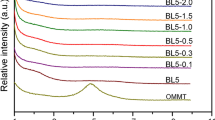Abstract
Carbon black (CB) is commonly used as filler in the rubber industry, although it is potentially polluting and its production demands high energy. It would be beneficial if other fillers could replace CB, even if only partially. Aramid fibers have been used in a range of applications in the rubber industry; however, their relatively inert surface is an obstacle for obtaining composites with enhanced properties. In this work, three ionic liquids were investigated as compatibilizers in the preparation of styrene-butadiene rubber composites with aramid pulp, which were characterized using swelling, hardness, and tensile tests, differential scanning calorimetry, thermogravimetric, and infrared spectroscopy analyses, as well as scanning electron microscopy. The ionic liquid-treated aramid pulp showed higher degree of fibrillation, and the composite with 5 phr of aramid pulp containing 0.5 wt.% of physisorbed ionic liquid showed the highest increment in tensile strength, ca. 42% superior to the IL-free composite, confirming the potential of imidazolium ionic liquids to act as compatibilizers and greatly outperforming related previous work due to differences in the composite preparation techniques.





Similar content being viewed by others
References
Zhang Y, Zhang Q, Liu Q, Cheng H, Frost RL (2014) Thermal stability of styrene butadiene rubber (SBR) composites filled with kaolinite/silica hybrid filler. J Therm Anal Calorim 115(2):1013–1020. https://doi.org/10.1007/s10973-013-3382-y
Chilan C, Wenxia W, Jianguo Z (2016) The effect of surface functionality of carbon nanotubes on mechanical and tribological behaviours of carbon fibre-filled styrene-butadiene rubber composite. J Thermoplast Compos Mater 29(9):1167–1175. https://doi.org/10.1177/0892705714556834
Zhong B, Dong H, Lin J et al (2017) Preparation of halloysite nanotubes/silica hybrid supported vulcanization accelerator for enhancing interfacial and mechanical strength of rubber composites. Ind Eng Chem Res. https://doi.org/10.1021/acs.iecr.7b02250
Nillawong M, Sae-oui P, Suchiva K, Sirisinha C (2016) Properties of Sbr filled with carbon black and aramid pulp hybrid filler: comparison between predispersed aramid pulp and conventional aramid pulp. Rubber Chem Technol 89(4):640–652. https://doi.org/10.5254/rct.16.83803
Raza MA, Ashraf MA, Westwood AVK et al (2016) Maleated high oleic sunflower oil-treated cellulose fiber-based styrene butadiene rubber composites. Polym Polym Compos 37(4):1113–1121. https://doi.org/10.1002/pc.23273
Subramaniam K, Das A, Stöckelhuber KW, Heinrich G (2013) Elastomer composites based on carbon nanotubes and ionic liquid. Rubber Chem Technol 86(3):367–400. https://doi.org/10.5254/rct.13.86984
Mao Y, Li S, Fang RL, Ploehn HJ (2017) Magadiite/styrene-butadiene rubber composites for tire tread applications: effects of varying layer spacing and alternate inorganic fillers. J Appl Polym Sci 134(18):1–13. https://doi.org/10.1002/app.44764
Gopi JA, Patel SK, Tripathy DK, Chandra AK (2016) Development of cooler running PCR tire tread using SBR-ENR-nano clay composite. Int J Plast Technol 20(2):345–363. https://doi.org/10.1007/s12588-016-9159-y
Wennekes WB, Datta RN, Noordermeer JWM (2008) Fiber adhesion to rubber compounds. Rubber Chem Technol 81(3):523–540. https://doi.org/10.5254/1.3548218
Wang L, Shi Y, Sa R et al (2016) Surface modification of aramid fibers by catechol/polyamine codeposition followed by silane grafting for enhanced interfacial adhesion to rubber matrix. Ind Eng Chem Res 55(49):12547–12556. https://doi.org/10.1021/acs.iecr.6b03177
Dewilde S, Dehaen W, Binnemans K (2016) Ionic liquids as solvents for PPTA oligomers. Green Chem 18(6):1639–1652. https://doi.org/10.1039/C5GC02185E
Wang CX, Du M, Lv JC et al (2015) Surface modification of aramid fiber by plasma induced vapor phase graft polymerization of acrylic acid. I. Influence of plasma conditions. Appl Surf Sci 349:333–342. https://doi.org/10.1016/j.apsusc.2015.05.036
Sun Y, Liang Q, Chi H et al (2014) The application of gas plasma technologies in surface modification of aramid fiber. Fibers Polym 15(1):1–7. https://doi.org/10.1007/s12221-014-0001-x
Li S, Han K, Rong H, Li X, Yu M (2014) Surface modification of aramid fibers via ammonia–plasma treatment. J Appl Polym Sci 131(10):1–6. https://doi.org/10.1002/app.40250
Zhao J (2013) Effect of surface treatment on the structure and properties of para-aramid fibers by phosphoric acid. Fibers Polym 14(1):59–64. https://doi.org/10.1007/s12221-013-0059-x
Lin JS (2002) Effect of surface modification by bromination and metalation on Kevlar fibre-epoxy adhesion. Eur Polym J 38(1):79–86. https://doi.org/10.1016/S0014-3057(01)00176-8
da Silva VD, Jacobi MM, Schrekker HS, Amico SC (2018) Aramid pulp with physisorbed imidazolium ionic liquids for solvent-casted enhanced styrene-butadiene rubber composites. J Appl Polym Sci. 135(36):46693. https://doi.org/10.1002/app.46693
Schrekker HS, Silva DO, Gelesky MA et al (2008) Preparation, cation–anion interactions and physicochemical properties of ether-functionalized imidazolium ionic liquids. J Braz Chem Soc 19(3):426–433. https://doi.org/10.1590/S0103-50532008000300009
Villar-Rodil S, Paredes JI, Martínez-Alonso A, Tascón JMD (2001) Atomic force microscopy and infrared spectroscopy studies of the thermal degradation of nomex aramid fibers. Chem Mater 13(11):4297–4304. https://doi.org/10.1021/cm001219f
Wu J, Cheng XH (2006) Effect of surface treatment on the mechanical and tribological performance of Kevlar pulp reinforced epoxy composites. Tribol Lett 24(3):195–199. https://doi.org/10.1007/s11249-006-9138-0
Brandt A, Ray MJ, To TQ, Leak DJ, Murphy RJ, Welton T (2011) Ionic liquid pretreatment of lignocellulosic biomass with ionic liquid–water mixtures. Green Chem 13(9):2489–2499. https://doi.org/10.1039/c1gc15374a
Macmillan AC, McIntire TM, Epstein SA, Nizkorodov SA (2014) Effect of alkyl chain length on hygroscopicity of nanoparticles and thin films of imidazolium-based ionic liquids. J Phys Chem C 118(50):29458–29466. https://doi.org/10.1021/jp503049j
Kraus G (1963) Swelling of filler-reinforced vulcanizates. J Appl Polym Sci 7:861–871
Narimissa E, Gupta RK, Kao N, Choi HJ, Bhattacharya SN (2015) The comparison between the effects of solvent casting and melt intercalation mixing processes on different characteristics of polylactide–nanographite platelets composites. Polym Eng Sci 55(7):1560–1570. https://doi.org/10.1002/pen
Chatzi EG, Koenig JL (1987) Morphology and structure of Kevlar fibers: a review. Polym Plast Technol Eng 26(3–4):229–270. https://doi.org/10.1080/03602558708071938
Hintze C, Shirazi M, Wiessner S, Talma AG, Heinrich G, Noordermeer JWM (2013) Influence of fiber type and coating on the composite properties of EPDM compounds reinforced with short aramid fibers. Rubber Chem Technol 86(4):579–590. https://doi.org/10.5254/rct.13.87977
Hunter BA, Nawakowski AC, Barnhart RR, Campbell EM, Hansen EB (1960) Important stability factors for styrene-butadiene rubber. Rubber Chem Technol 33(2):510–527. https://doi.org/10.5254/1.3542170
Acknowledgements
The authors thank CAPES and CNPq for the financial support. DuPont is kindly acknowledged for the donation of AP.
Author information
Authors and Affiliations
Corresponding author
Rights and permissions
About this article
Cite this article
Demétrio da Silva, V., Jacobi, M.M., Schrekker, H.S. et al. Imidazolium ionic liquid compatibilizers in melt-blended styrene-butadiene rubber/aramid pulp composites. Polym. Bull. 76, 3451–3462 (2019). https://doi.org/10.1007/s00289-018-2550-4
Received:
Revised:
Accepted:
Published:
Issue Date:
DOI: https://doi.org/10.1007/s00289-018-2550-4



